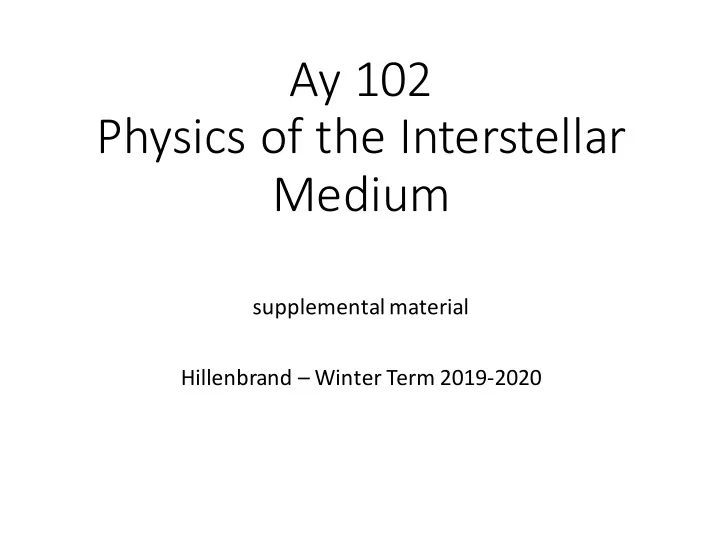

Ay 102 Physics of the Interstellar Medium supplemental material Hillenbrand – Winter Term 2019-2020
Radiative Transfer • The interaction of photons and matter! whfreeman.com • Important variables: • energy of the photons ( è frequency) • temperature and density of the gas ( è cross section) • presence and size of dust ( è cross section)
I λ n 1 , σ 1 n 2 , σ 2 n, σ I λ recall that n σ = k ρ Can also have an emission component, which contributes photons instead of removing them è d I ν = j ν ρ ds D. Fischer
Equation of Radiative Transfer Optical depth τ ν ( with d τ ν = κ ν ρ ds) accounts for interaction between matter and the radiation field. In analyzing spectra need to consider both continuum and line processes.
Illustration (courtesy of K. Dullemond)
Rad. trans. through a cloud of fixed T T cloud τ cloud I ν ,bg I ν ,out T bg =6000 K S ν < I ν
Rad. trans. through a cloud of fixed T T cloud τ cloud I ν ,bg I ν ,out T bg =6000 K S ν < I ν
Rad. trans. through a cloud of fixed T T cloud τ cloud I ν ,bg I ν ,out T bg =6000 K S ν < I ν
Rad. trans. through a cloud of fixed T T cloud τ cloud I ν ,bg I ν ,out T bg =6000 K S ν < I ν
Rad. trans. through a cloud of fixed T T cloud τ cloud I ν ,bg I ν ,out T bg =6000 K S ν > I ν
Rad. trans. through a cloud of fixed T T cloud τ cloud I ν ,bg I ν ,out T bg =6000 K S ν > I ν
Rad. trans. through a cloud of fixed T T cloud τ cloud I ν ,bg I ν ,out T bg =6000 K S ν > I ν
Rad. trans. through a cloud of fixed T T cloud τ cloud I ν ,bg I ν ,out T bg =6000 K S ν > I ν
Many Ways to Remove Photons = Opacity ( continuum opacity) ( line opacity) ( continuum opacity) D. Fischer
Many Ways to Remove Photons = Opacity ( continuum opacity) ( continuum opacity) D. Fischer
Resulting Total Absorption Cross Section Opacity is entirely from gas below the lyman limit Opacity is mostly Showing wavelength from dust at UV through infrared dependence of the and millimeter continuum only. There can also be superposed line opacity. 10 µ m 1 µ m 0.1 µ m
T. Montmerle
It Doesn’t Take Much Column to Get Rid of UV (showing continuum and lines ) Far Soft Extreme-UV Hard x-ray -UV x-ray This is a hot emission 12.4 nm region seen through increasing amounts of cooler gas. à Av = 1 mag Ercolano & Pascucci
Radiative Transfer and Spectral Lines • Concerning line opacity, we are going to spend some time understanding energy levels and the “transitions” between them for: • Atoms / Ions (Grotrian diagrams for electronic levels) • Molecules (Jablonski diagrams for rotational and vibrational) • The balance of the upward and downward transitions -- combined with the 1/ 4 π directional probability for photon emission −− is a source of opacity. • Then the solutions to the Radiative Transfer Equation determine what we actually observe.
Line Profiles and Strengths
Emission vs. absorption lines Hot foreground layer Cool foreground layer Flux Flux l l K. Dullemond
how strong is the line? J. Williams
Thermal Line Width Profile strength F ν σ ν line ν K. Dullemond
Illustration (courtesy of K. Dullemond)
Emission vs. absorption lines T cloud τ cloud I ν ,bg I ν ,out T bg =6000 K
Emission vs. absorption lines T cloud τ cloud I ν ,bg I ν ,out T bg =6000 K
Emission vs. absorption lines T cloud τ cloud I ν ,bg I ν ,out T bg =6000 K
Emission vs. absorption lines T cloud τ cloud I ν ,bg I ν ,out T bg =6000 K line is “saturated”
Emission vs. absorption lines T cloud τ cloud I ν ,bg I ν ,out T bg =6000 K
Emission vs. absorption lines T cloud τ cloud I ν ,bg I ν ,out T bg =6000 K
Emission vs. absorption lines T cloud τ cloud I ν ,bg I ν ,out T bg =6000 K
Emission vs. absorption lines T cloud τ cloud I ν ,bg I ν ,out T bg =6000 K line is “saturated”
IGM example
Lyman Series Absorption è N HI line is “saturated” higher level Flux lines from same species are weaker Velocity
Recommend
More recommend